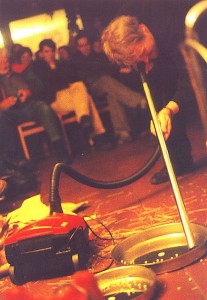Created by Christopher DeLaurenti.
He writes, “Phonography has been sometimes been defined as “creative field recording,” taking and placing microphones out into the world in unusual ways and unexpected places. In this program phonographer Christopher DeLaurenti presents several specimens of subaudible phonography – field recordings from outside the realm of human hearing.
This program features four examples. “Below the written pitches of Brian Ferneyhough’s ‘Superscriptio’ for solo piccolo” spectrally extracts sound beneath the written pitches of Brian Ferneyhough’s “Superscriptio” to reveal recording anomalies, latent undertones, and mechanical noises. It’s akin to hearing the piece through a hydrophone.
In “Silences normalized from the complete organ works of Olivier Messiaen (part 1)” I amplified room tone to reveal the inner workings of an organ and its environment, including residual tones, traffic, stray speech, and tiny electrical anomalies.
The third example is an odd specimen of radio transmission—a rarity for its length and depth of activity: “Open Carrier, Citywide One Manhattan.”
In the United States, an “open carrier” is police parlance for a radio that has been inadvertently left on in Talk/Transmit mode. An open carrier stalls and paralyses broadcast traffic, leaving so-called “dead air” to reveal sudden gaps, smudges of hiss, gently swaying drones, beeping alerts, fragmented words, quick phrases, recessed conversations, and other unexpected artifacts. It’s like butt-dialing everyone who is listening to the radio. I recorded this example by accident in 2004 during the protest against then-president George W. Bush and the Republican National Convention in New York.
The final example is an excerpt from “of silences intemporally sung: Luigi Nono’s Fragmente-Stille, an Diotima.” Here, I have inverted Nono’s only string quartet by muting the audible passages played by a string quartet. Then I elevated room tone, discreet ambiance, and other assumed silences above the threshold of audibility. You will hear on-the-fly tunings, annunciatory gasps, hurried breaths, sul ponticello bowings, and creaking chairs; these eruptions and outcries fuse with flickers of ambient sound. You might also hear artifacts of the recording process, especially digital glitches and artificial echo. Visit delaurenti.net for more about Christopher DeLaurenti and subaudible phonography.”
More information at https://wavefarm.org/radio/wgxc/audio-archive/y0dgtt


